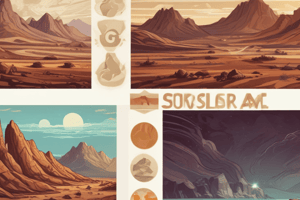Podcast
Questions and Answers
What are some essential functions of nutrients in plant processes?
What are some essential functions of nutrients in plant processes?
- Energy transfer
- Enzyme function
- Maintenance of internal turgor pressure
- All of the above (correct)
Organic fertilizers are reliable in most areas due to their fast decomposition process.
Organic fertilizers are reliable in most areas due to their fast decomposition process.
False (B)
What is eutrophication?
What is eutrophication?
Eutrophication is the process in which a water body becomes overly enriched with nutrients, leading to plentiful growth of simple plant life.
Most plant nutrients are in their most available state at pH 6.5-7.
Most plant nutrients are in their most available state at pH 6.5-7.
What are the primary components of soil?
What are the primary components of soil?
Clay soil holds more water but less air compared to sandy soil.
Clay soil holds more water but less air compared to sandy soil.
What is the role of humus in soil?
What is the role of humus in soil?
The optimum pH range for the majority of plants to grow is between $______$.
The optimum pH range for the majority of plants to grow is between $______$.
Match the following soil horizons with their descriptions:
Match the following soil horizons with their descriptions:
Flashcards are hidden until you start studying
Study Notes
Importance of Soil
- Soil provides mechanical support to plants by allowing roots to grow through it
- Soil holds water, nutrients, and air essential for plant growth
Soil Definition
- Thin layer of the Earth's crust
- Unconsolidated mixture of disintegrated rock with:
- Organic matter
- Water
- Air
- Microorganisms
Soil Components
- Mineral particles of weathered rocks
- Water and dissolved mineral salts
- Air in spaces between particles
- Dead organic matter (humus)
- Microorganisms
Soil Texture
- Classified into four types based on particle size:
- Clay (< 0.002 mm)
- Silt (0.02 mm - 0.002 mm)
- Fine sand (0.2 mm - 0.02 mm)
- Coarse sand (2.0 mm - 0.2 mm)
Types of Soils
- Clayey soil: heavy, poor drainage, and moldable
- Sandy soil: light, good aeration, and fast drainage
- Loam soil: composed of equal amounts of clay, silt, and sand
- Silt soil: medium pore size, good drainage, and fertile
Soil Profile (Layers)
- Every soil has a profile with multiple layers:
- 0 horizon (soil surface): few centimeters thick, contains fallen leaves
- A horizon (topsoil): 10-30 cm below the surface, contains 10-15% organic matter
- B horizon (subsoil): large soil particles, little organic matter, and minerals washed from topsoil
- C horizon (bedrock or hardpan): compacted soil, no organic matter, and poor drainage
Soil Organisms
- Beneficial organisms:
- Form part of the soil complex
- Improve drainage and aeration
- Aid in plant nutrient and water uptake
- Some are harmful, causing plant injuries or diseases
- Examples of soil organisms: nematodes, insects, earthworms, fungi, and bacteria
Organic Matter in Soil
- When plants and animals decompose, they form humus
- Soils lacking organic matter and humus are light in color
- Humus is important for:
- Holding moisture
- Absorbing and holding plant nutrients
- Feeding soil organisms
Soil Erosion
- Movement of soil particles from one place to another due to:
- Water (heavy rainfall or irrigation)
- Wind
- Can be controlled by growing plants with extensive, fibrous roots
Soil pH
- Measures the hydrogen ion concentration in soil
- Affects soil characteristics and plant growth
- pH scale: 0 (extreme acidic) to 14 (extreme alkaline)
- Optimum pH range for most plants: 6.5 - 7.0
Soil Improvement
- Can be improved by adding amendments:
- Inorganic amendments (e.g., vermiculite, perlite)
- Organic amendments (e.g., compost, humus)
- Amendments should be used in large amounts (about 25% of the soil volume)
Soil of Desert and Kuwait
- Desert soils: mostly sandy, saline, and poor in some elements
- Kuwait soils: mostly sandy, calcareous, and with accumulations of carbonate, gypsum, and salts
Water and Soil
- Importance of water to plants:
- Carries soluble minerals
- Essential for photosynthesis
- Essential for transpiration and regulating internal temperature
- Keeps cells turgid
- Water availability:
- Field water capacity: maximum amount of water held by a soil
- Permanent wilting capacity: minimum amount of water available for plant growth
- Water availability = Field water capacity - Permanent wilting capacity
Irrigation and Drainage
- Irrigation: watering plants by rainfall or other sources
- Drainage: rate at which water flows through the soil or potting medium
- Good drainage is recognized by fast water flow and low retention
Studying That Suits You
Use AI to generate personalized quizzes and flashcards to suit your learning preferences.




